BCO5501 - Business Process Engineering: Comprehensive BPM Review
VerifiedAdded on 2023/06/04
|10
|3203
|62
Essay
AI Summary
This essay presents a comprehensive review of four articles relevant to Business Process Engineering (BPM). It covers topics such as the relationship between BPM maturity and innovation in large companies, the verification of business processes, a literature review on BPM, reengineering, and innovation, and the impact of BPM on environmental management. The review discusses the research methods, findings, and conclusions of each article, highlighting their significance in understanding and improving business processes. It also identifies gaps in existing research and suggests areas for future studies, emphasizing the importance of BPM in various industries and its potential for driving innovation and sustainability. Desklib provides students with access to similar solved assignments and past papers.

Business Process Engineering 1
BUSINESS PROCESS ENGINEERING
Name
Course
Tutor
University
Date
BUSINESS PROCESS ENGINEERING
Name
Course
Tutor
University
Date
Paraphrase This Document
Need a fresh take? Get an instant paraphrase of this document with our AI Paraphraser

Business Process Engineering 2
Table of Contents
Statement of purpose.......................................................................................................................2
How do BPM Maturity and Innovation Relate in Large Companies?.............................................2
Business process verification-finally a reality.................................................................................4
Literature review on Business Process Management, Reengineering and Innovation....................5
Business Process Management: Saving the Planet?........................................................................6
Conclusion.......................................................................................................................................7
Reference List..................................................................................................................................8
Introduction
Statement of purpose
This report focuses on reviewing four articles which are relevant to business process
engineering or BPM. The objective of this task is to describe the main contents of the articles.
The review will be centered on discussions relating to the research methods and findings of the
journal articles. This task plays a significant role in helping students evaluate areas of significant
in business management process as discussed in the articles and in line with international
Conference on Business Process Management. The articles to be discussed include:
Anand A., Fosso Wamba S.,and Gnanzou D. (2013) A Literature Review on Business Process
Management, Business Process Reengineering, and Business Process Innovation. In: Barjis J.,
Gupta A., Meshkat A. (eds) Enterprise and Organizational Modeling and Simulation. EOMAS
2013. Lecture Notes in Business Information Processing, vol 153. Springer, Berlin, Heidelberg
Gohar, S.R. and Indulska, M., (2016). Business Process Management: Saving the Planet?. arXiv
preprint arXiv:1606.02459.
Widmann, V., de Waal, B.M. and Ravesteyn, P., (2018), March. How Do BPM Maturity and
Innovation Relate in Large Companies?. In World Conference on Information Systems and
Technologies (pp. 87-96). Springer, Cham.
Table of Contents
Statement of purpose.......................................................................................................................2
How do BPM Maturity and Innovation Relate in Large Companies?.............................................2
Business process verification-finally a reality.................................................................................4
Literature review on Business Process Management, Reengineering and Innovation....................5
Business Process Management: Saving the Planet?........................................................................6
Conclusion.......................................................................................................................................7
Reference List..................................................................................................................................8
Introduction
Statement of purpose
This report focuses on reviewing four articles which are relevant to business process
engineering or BPM. The objective of this task is to describe the main contents of the articles.
The review will be centered on discussions relating to the research methods and findings of the
journal articles. This task plays a significant role in helping students evaluate areas of significant
in business management process as discussed in the articles and in line with international
Conference on Business Process Management. The articles to be discussed include:
Anand A., Fosso Wamba S.,and Gnanzou D. (2013) A Literature Review on Business Process
Management, Business Process Reengineering, and Business Process Innovation. In: Barjis J.,
Gupta A., Meshkat A. (eds) Enterprise and Organizational Modeling and Simulation. EOMAS
2013. Lecture Notes in Business Information Processing, vol 153. Springer, Berlin, Heidelberg
Gohar, S.R. and Indulska, M., (2016). Business Process Management: Saving the Planet?. arXiv
preprint arXiv:1606.02459.
Widmann, V., de Waal, B.M. and Ravesteyn, P., (2018), March. How Do BPM Maturity and
Innovation Relate in Large Companies?. In World Conference on Information Systems and
Technologies (pp. 87-96). Springer, Cham.
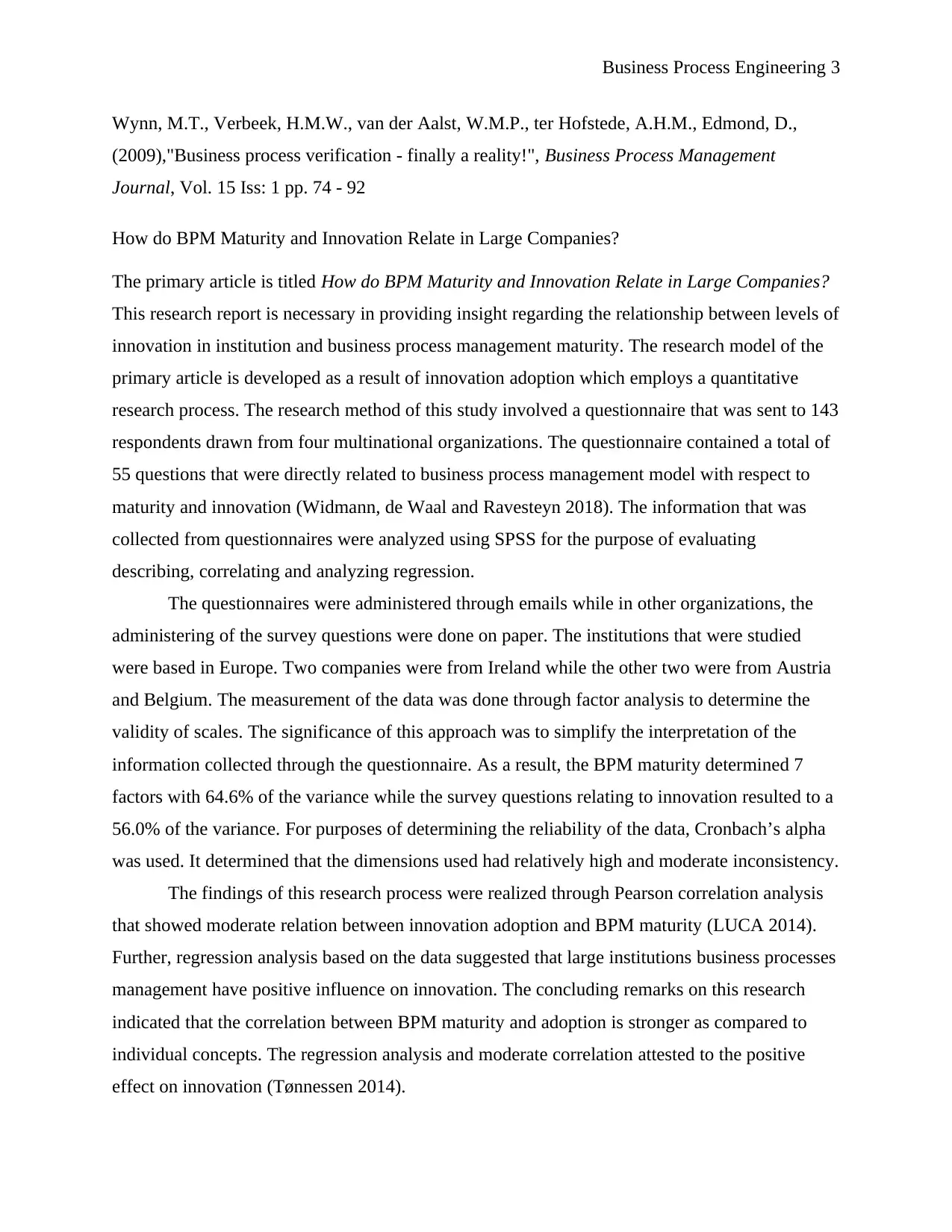
Business Process Engineering 3
Wynn, M.T., Verbeek, H.M.W., van der Aalst, W.M.P., ter Hofstede, A.H.M., Edmond, D.,
(2009),"Business process verification - finally a reality!", Business Process Management
Journal, Vol. 15 Iss: 1 pp. 74 - 92
How do BPM Maturity and Innovation Relate in Large Companies?
The primary article is titled How do BPM Maturity and Innovation Relate in Large Companies?
This research report is necessary in providing insight regarding the relationship between levels of
innovation in institution and business process management maturity. The research model of the
primary article is developed as a result of innovation adoption which employs a quantitative
research process. The research method of this study involved a questionnaire that was sent to 143
respondents drawn from four multinational organizations. The questionnaire contained a total of
55 questions that were directly related to business process management model with respect to
maturity and innovation (Widmann, de Waal and Ravesteyn 2018). The information that was
collected from questionnaires were analyzed using SPSS for the purpose of evaluating
describing, correlating and analyzing regression.
The questionnaires were administered through emails while in other organizations, the
administering of the survey questions were done on paper. The institutions that were studied
were based in Europe. Two companies were from Ireland while the other two were from Austria
and Belgium. The measurement of the data was done through factor analysis to determine the
validity of scales. The significance of this approach was to simplify the interpretation of the
information collected through the questionnaire. As a result, the BPM maturity determined 7
factors with 64.6% of the variance while the survey questions relating to innovation resulted to a
56.0% of the variance. For purposes of determining the reliability of the data, Cronbach’s alpha
was used. It determined that the dimensions used had relatively high and moderate inconsistency.
The findings of this research process were realized through Pearson correlation analysis
that showed moderate relation between innovation adoption and BPM maturity (LUCA 2014).
Further, regression analysis based on the data suggested that large institutions business processes
management have positive influence on innovation. The concluding remarks on this research
indicated that the correlation between BPM maturity and adoption is stronger as compared to
individual concepts. The regression analysis and moderate correlation attested to the positive
effect on innovation (Tønnessen 2014).
Wynn, M.T., Verbeek, H.M.W., van der Aalst, W.M.P., ter Hofstede, A.H.M., Edmond, D.,
(2009),"Business process verification - finally a reality!", Business Process Management
Journal, Vol. 15 Iss: 1 pp. 74 - 92
How do BPM Maturity and Innovation Relate in Large Companies?
The primary article is titled How do BPM Maturity and Innovation Relate in Large Companies?
This research report is necessary in providing insight regarding the relationship between levels of
innovation in institution and business process management maturity. The research model of the
primary article is developed as a result of innovation adoption which employs a quantitative
research process. The research method of this study involved a questionnaire that was sent to 143
respondents drawn from four multinational organizations. The questionnaire contained a total of
55 questions that were directly related to business process management model with respect to
maturity and innovation (Widmann, de Waal and Ravesteyn 2018). The information that was
collected from questionnaires were analyzed using SPSS for the purpose of evaluating
describing, correlating and analyzing regression.
The questionnaires were administered through emails while in other organizations, the
administering of the survey questions were done on paper. The institutions that were studied
were based in Europe. Two companies were from Ireland while the other two were from Austria
and Belgium. The measurement of the data was done through factor analysis to determine the
validity of scales. The significance of this approach was to simplify the interpretation of the
information collected through the questionnaire. As a result, the BPM maturity determined 7
factors with 64.6% of the variance while the survey questions relating to innovation resulted to a
56.0% of the variance. For purposes of determining the reliability of the data, Cronbach’s alpha
was used. It determined that the dimensions used had relatively high and moderate inconsistency.
The findings of this research process were realized through Pearson correlation analysis
that showed moderate relation between innovation adoption and BPM maturity (LUCA 2014).
Further, regression analysis based on the data suggested that large institutions business processes
management have positive influence on innovation. The concluding remarks on this research
indicated that the correlation between BPM maturity and adoption is stronger as compared to
individual concepts. The regression analysis and moderate correlation attested to the positive
effect on innovation (Tønnessen 2014).
⊘ This is a preview!⊘
Do you want full access?
Subscribe today to unlock all pages.

Trusted by 1+ million students worldwide
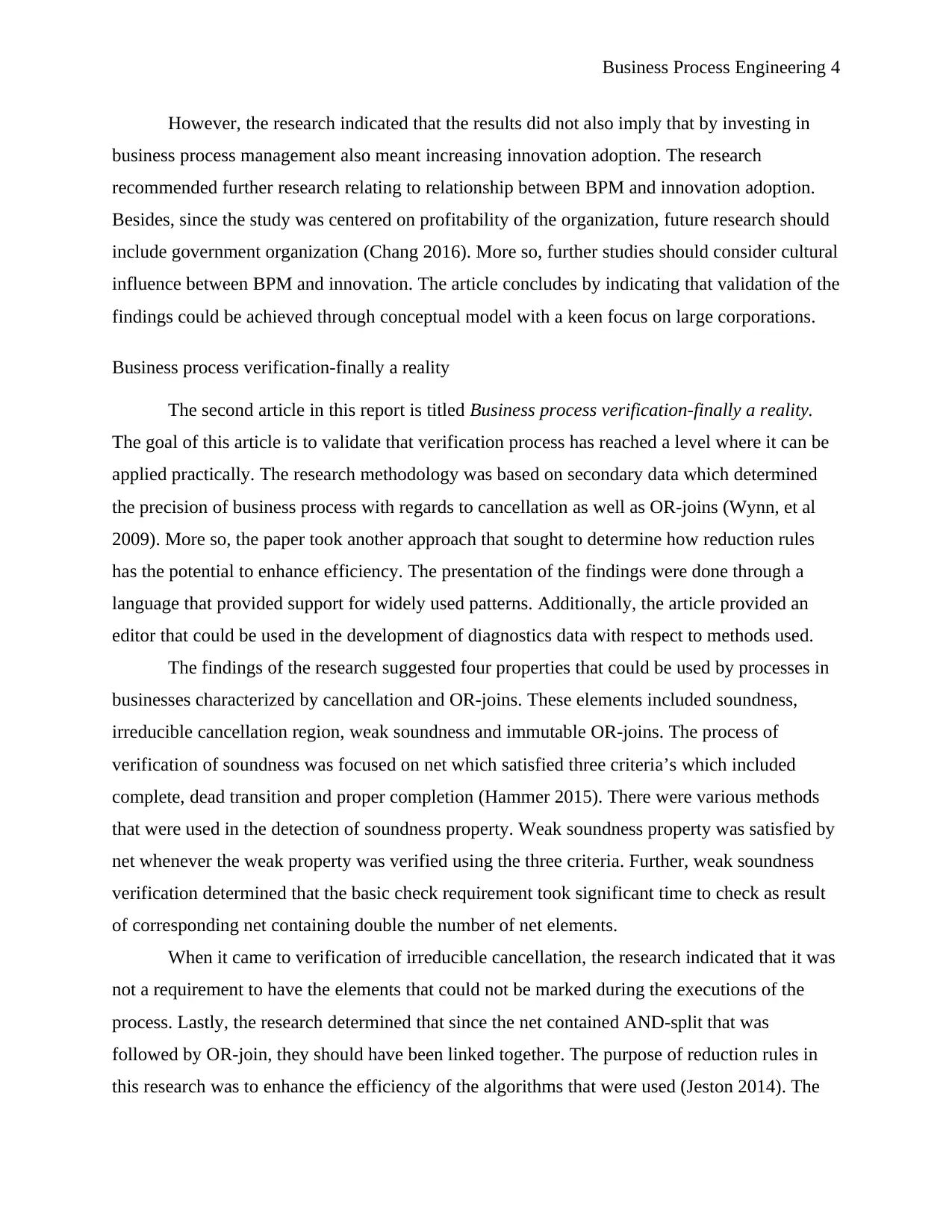
Business Process Engineering 4
However, the research indicated that the results did not also imply that by investing in
business process management also meant increasing innovation adoption. The research
recommended further research relating to relationship between BPM and innovation adoption.
Besides, since the study was centered on profitability of the organization, future research should
include government organization (Chang 2016). More so, further studies should consider cultural
influence between BPM and innovation. The article concludes by indicating that validation of the
findings could be achieved through conceptual model with a keen focus on large corporations.
Business process verification-finally a reality
The second article in this report is titled Business process verification-finally a reality.
The goal of this article is to validate that verification process has reached a level where it can be
applied practically. The research methodology was based on secondary data which determined
the precision of business process with regards to cancellation as well as OR-joins (Wynn, et al
2009). More so, the paper took another approach that sought to determine how reduction rules
has the potential to enhance efficiency. The presentation of the findings were done through a
language that provided support for widely used patterns. Additionally, the article provided an
editor that could be used in the development of diagnostics data with respect to methods used.
The findings of the research suggested four properties that could be used by processes in
businesses characterized by cancellation and OR-joins. These elements included soundness,
irreducible cancellation region, weak soundness and immutable OR-joins. The process of
verification of soundness was focused on net which satisfied three criteria’s which included
complete, dead transition and proper completion (Hammer 2015). There were various methods
that were used in the detection of soundness property. Weak soundness property was satisfied by
net whenever the weak property was verified using the three criteria. Further, weak soundness
verification determined that the basic check requirement took significant time to check as result
of corresponding net containing double the number of net elements.
When it came to verification of irreducible cancellation, the research indicated that it was
not a requirement to have the elements that could not be marked during the executions of the
process. Lastly, the research determined that since the net contained AND-split that was
followed by OR-join, they should have been linked together. The purpose of reduction rules in
this research was to enhance the efficiency of the algorithms that were used (Jeston 2014). The
However, the research indicated that the results did not also imply that by investing in
business process management also meant increasing innovation adoption. The research
recommended further research relating to relationship between BPM and innovation adoption.
Besides, since the study was centered on profitability of the organization, future research should
include government organization (Chang 2016). More so, further studies should consider cultural
influence between BPM and innovation. The article concludes by indicating that validation of the
findings could be achieved through conceptual model with a keen focus on large corporations.
Business process verification-finally a reality
The second article in this report is titled Business process verification-finally a reality.
The goal of this article is to validate that verification process has reached a level where it can be
applied practically. The research methodology was based on secondary data which determined
the precision of business process with regards to cancellation as well as OR-joins (Wynn, et al
2009). More so, the paper took another approach that sought to determine how reduction rules
has the potential to enhance efficiency. The presentation of the findings were done through a
language that provided support for widely used patterns. Additionally, the article provided an
editor that could be used in the development of diagnostics data with respect to methods used.
The findings of the research suggested four properties that could be used by processes in
businesses characterized by cancellation and OR-joins. These elements included soundness,
irreducible cancellation region, weak soundness and immutable OR-joins. The process of
verification of soundness was focused on net which satisfied three criteria’s which included
complete, dead transition and proper completion (Hammer 2015). There were various methods
that were used in the detection of soundness property. Weak soundness property was satisfied by
net whenever the weak property was verified using the three criteria. Further, weak soundness
verification determined that the basic check requirement took significant time to check as result
of corresponding net containing double the number of net elements.
When it came to verification of irreducible cancellation, the research indicated that it was
not a requirement to have the elements that could not be marked during the executions of the
process. Lastly, the research determined that since the net contained AND-split that was
followed by OR-join, they should have been linked together. The purpose of reduction rules in
this research was to enhance the efficiency of the algorithms that were used (Jeston 2014). The
Paraphrase This Document
Need a fresh take? Get an instant paraphrase of this document with our AI Paraphraser
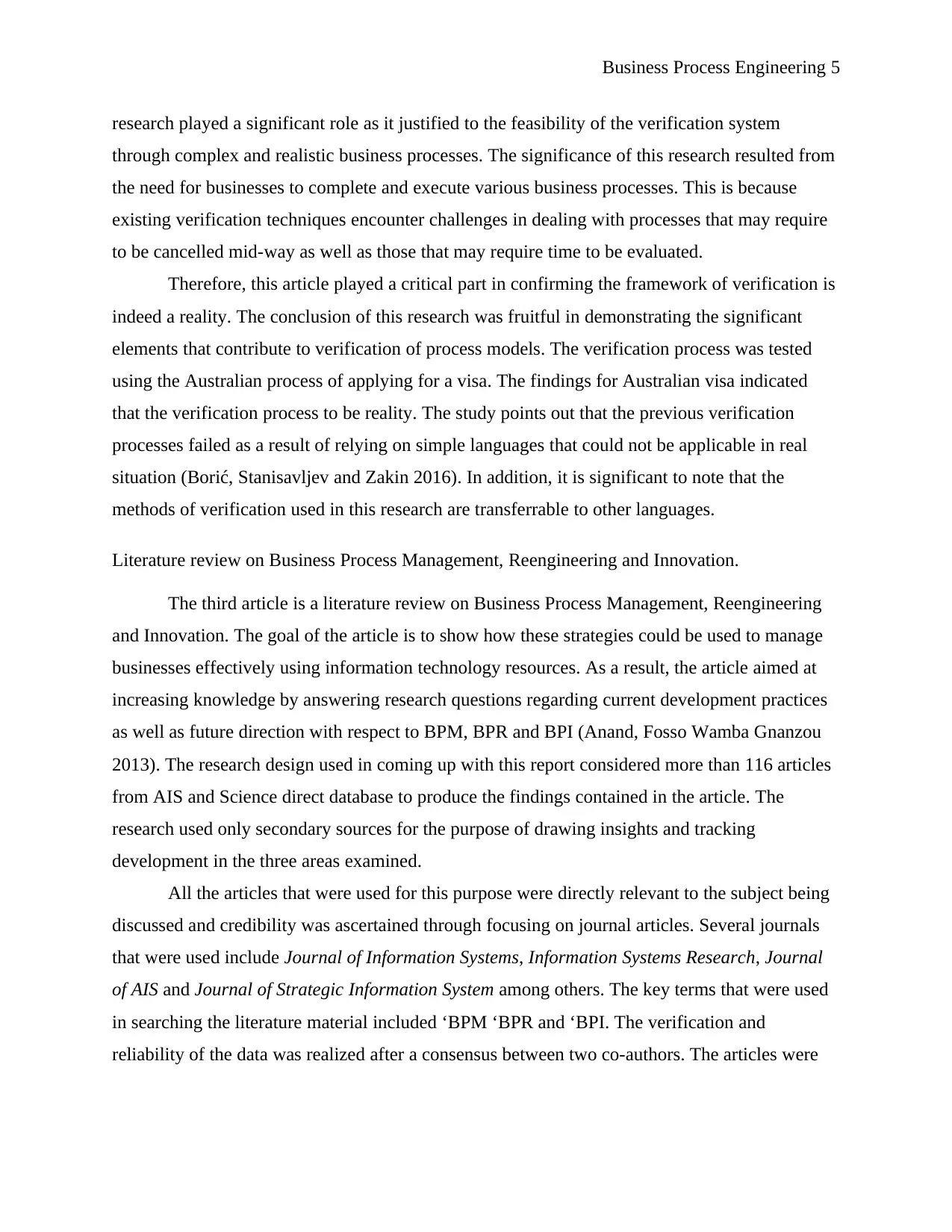
Business Process Engineering 5
research played a significant role as it justified to the feasibility of the verification system
through complex and realistic business processes. The significance of this research resulted from
the need for businesses to complete and execute various business processes. This is because
existing verification techniques encounter challenges in dealing with processes that may require
to be cancelled mid-way as well as those that may require time to be evaluated.
Therefore, this article played a critical part in confirming the framework of verification is
indeed a reality. The conclusion of this research was fruitful in demonstrating the significant
elements that contribute to verification of process models. The verification process was tested
using the Australian process of applying for a visa. The findings for Australian visa indicated
that the verification process to be reality. The study points out that the previous verification
processes failed as a result of relying on simple languages that could not be applicable in real
situation (Borić, Stanisavljev and Zakin 2016). In addition, it is significant to note that the
methods of verification used in this research are transferrable to other languages.
Literature review on Business Process Management, Reengineering and Innovation.
The third article is a literature review on Business Process Management, Reengineering
and Innovation. The goal of the article is to show how these strategies could be used to manage
businesses effectively using information technology resources. As a result, the article aimed at
increasing knowledge by answering research questions regarding current development practices
as well as future direction with respect to BPM, BPR and BPI (Anand, Fosso Wamba Gnanzou
2013). The research design used in coming up with this report considered more than 116 articles
from AIS and Science direct database to produce the findings contained in the article. The
research used only secondary sources for the purpose of drawing insights and tracking
development in the three areas examined.
All the articles that were used for this purpose were directly relevant to the subject being
discussed and credibility was ascertained through focusing on journal articles. Several journals
that were used include Journal of Information Systems, Information Systems Research, Journal
of AIS and Journal of Strategic Information System among others. The key terms that were used
in searching the literature material included ‘BPM ‘BPR and ‘BPI. The verification and
reliability of the data was realized after a consensus between two co-authors. The articles were
research played a significant role as it justified to the feasibility of the verification system
through complex and realistic business processes. The significance of this research resulted from
the need for businesses to complete and execute various business processes. This is because
existing verification techniques encounter challenges in dealing with processes that may require
to be cancelled mid-way as well as those that may require time to be evaluated.
Therefore, this article played a critical part in confirming the framework of verification is
indeed a reality. The conclusion of this research was fruitful in demonstrating the significant
elements that contribute to verification of process models. The verification process was tested
using the Australian process of applying for a visa. The findings for Australian visa indicated
that the verification process to be reality. The study points out that the previous verification
processes failed as a result of relying on simple languages that could not be applicable in real
situation (Borić, Stanisavljev and Zakin 2016). In addition, it is significant to note that the
methods of verification used in this research are transferrable to other languages.
Literature review on Business Process Management, Reengineering and Innovation.
The third article is a literature review on Business Process Management, Reengineering
and Innovation. The goal of the article is to show how these strategies could be used to manage
businesses effectively using information technology resources. As a result, the article aimed at
increasing knowledge by answering research questions regarding current development practices
as well as future direction with respect to BPM, BPR and BPI (Anand, Fosso Wamba Gnanzou
2013). The research design used in coming up with this report considered more than 116 articles
from AIS and Science direct database to produce the findings contained in the article. The
research used only secondary sources for the purpose of drawing insights and tracking
development in the three areas examined.
All the articles that were used for this purpose were directly relevant to the subject being
discussed and credibility was ascertained through focusing on journal articles. Several journals
that were used include Journal of Information Systems, Information Systems Research, Journal
of AIS and Journal of Strategic Information System among others. The key terms that were used
in searching the literature material included ‘BPM ‘BPR and ‘BPI. The verification and
reliability of the data was realized after a consensus between two co-authors. The articles were

Business Process Engineering 6
considered in terms of geographical areas in order to draw an overview of practices in specific
areas.
Moreover, the classification of the articles were categorized in terms of review, data
analysis, survey, experiment, case study, development and other ethnographical research. Among
the covered topics that were used on in this research process included performance management,
learning people, change process, knowledge management, resources management, control,
planning and customer management (Rinaldi, Montanari and Bottani 2015). The goals that were
to be determined in the business process components included integrating and focusing value
delivery on customers, how institutions plan and deliver values to customers as well as
measuring operational performance. Regarding knowledge management, the goal was to
determine how organizations grow knowledge.
On the other hand, the objectives attained included identifying needs and wants,
developing products and services, obtaining constant customer satisfaction feedback,
establishing goals and policies, developing capabilities, obtaining performance levels among
other development solutions through innovation. The findings of this research determined that
even though the elements being discussed had existed for a long time, the journals had not
focused much on research regarding the specific areas (Huang et al 2015). Few of the journal
database that were used had significant information that could be used to draw findings.
The research recommended that extensive research should be conducted in the future in
order to evaluate both successes and failures of the surrounding subject areas. Since the
concentration of the articles was mainly from AIS database, future research could use a balance
of different database in order to determine different approaches as perceived by the authors.
There was little information regarding development and data analysis which was significant to
review BPM, BPR and BPI and future research should address. Besides the paper recommended
that research should have been done on various industries such as healthcare which is undergoing
significant changes among other industries such as supply chain, logistics and automotive
(Esbenshade et al 2016).
Business Process Management: Saving the Planet?.
The last article discussed in this report is based on whether business process management
can save the planet. The intention of the article was to evaluate the impact business process
considered in terms of geographical areas in order to draw an overview of practices in specific
areas.
Moreover, the classification of the articles were categorized in terms of review, data
analysis, survey, experiment, case study, development and other ethnographical research. Among
the covered topics that were used on in this research process included performance management,
learning people, change process, knowledge management, resources management, control,
planning and customer management (Rinaldi, Montanari and Bottani 2015). The goals that were
to be determined in the business process components included integrating and focusing value
delivery on customers, how institutions plan and deliver values to customers as well as
measuring operational performance. Regarding knowledge management, the goal was to
determine how organizations grow knowledge.
On the other hand, the objectives attained included identifying needs and wants,
developing products and services, obtaining constant customer satisfaction feedback,
establishing goals and policies, developing capabilities, obtaining performance levels among
other development solutions through innovation. The findings of this research determined that
even though the elements being discussed had existed for a long time, the journals had not
focused much on research regarding the specific areas (Huang et al 2015). Few of the journal
database that were used had significant information that could be used to draw findings.
The research recommended that extensive research should be conducted in the future in
order to evaluate both successes and failures of the surrounding subject areas. Since the
concentration of the articles was mainly from AIS database, future research could use a balance
of different database in order to determine different approaches as perceived by the authors.
There was little information regarding development and data analysis which was significant to
review BPM, BPR and BPI and future research should address. Besides the paper recommended
that research should have been done on various industries such as healthcare which is undergoing
significant changes among other industries such as supply chain, logistics and automotive
(Esbenshade et al 2016).
Business Process Management: Saving the Planet?.
The last article discussed in this report is based on whether business process management
can save the planet. The intention of the article was to evaluate the impact business process
⊘ This is a preview!⊘
Do you want full access?
Subscribe today to unlock all pages.

Trusted by 1+ million students worldwide
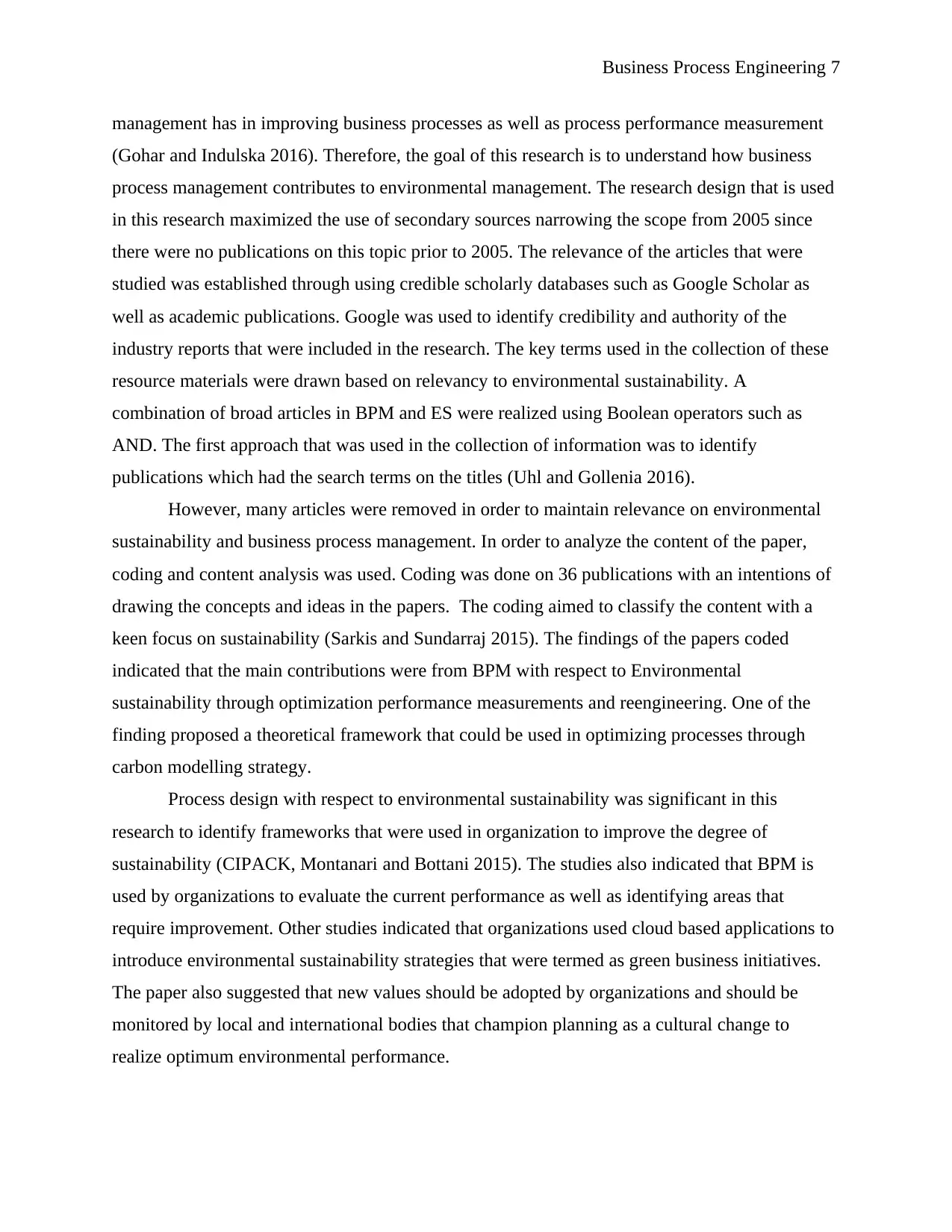
Business Process Engineering 7
management has in improving business processes as well as process performance measurement
(Gohar and Indulska 2016). Therefore, the goal of this research is to understand how business
process management contributes to environmental management. The research design that is used
in this research maximized the use of secondary sources narrowing the scope from 2005 since
there were no publications on this topic prior to 2005. The relevance of the articles that were
studied was established through using credible scholarly databases such as Google Scholar as
well as academic publications. Google was used to identify credibility and authority of the
industry reports that were included in the research. The key terms used in the collection of these
resource materials were drawn based on relevancy to environmental sustainability. A
combination of broad articles in BPM and ES were realized using Boolean operators such as
AND. The first approach that was used in the collection of information was to identify
publications which had the search terms on the titles (Uhl and Gollenia 2016).
However, many articles were removed in order to maintain relevance on environmental
sustainability and business process management. In order to analyze the content of the paper,
coding and content analysis was used. Coding was done on 36 publications with an intentions of
drawing the concepts and ideas in the papers. The coding aimed to classify the content with a
keen focus on sustainability (Sarkis and Sundarraj 2015). The findings of the papers coded
indicated that the main contributions were from BPM with respect to Environmental
sustainability through optimization performance measurements and reengineering. One of the
finding proposed a theoretical framework that could be used in optimizing processes through
carbon modelling strategy.
Process design with respect to environmental sustainability was significant in this
research to identify frameworks that were used in organization to improve the degree of
sustainability (CIPACK, Montanari and Bottani 2015). The studies also indicated that BPM is
used by organizations to evaluate the current performance as well as identifying areas that
require improvement. Other studies indicated that organizations used cloud based applications to
introduce environmental sustainability strategies that were termed as green business initiatives.
The paper also suggested that new values should be adopted by organizations and should be
monitored by local and international bodies that champion planning as a cultural change to
realize optimum environmental performance.
management has in improving business processes as well as process performance measurement
(Gohar and Indulska 2016). Therefore, the goal of this research is to understand how business
process management contributes to environmental management. The research design that is used
in this research maximized the use of secondary sources narrowing the scope from 2005 since
there were no publications on this topic prior to 2005. The relevance of the articles that were
studied was established through using credible scholarly databases such as Google Scholar as
well as academic publications. Google was used to identify credibility and authority of the
industry reports that were included in the research. The key terms used in the collection of these
resource materials were drawn based on relevancy to environmental sustainability. A
combination of broad articles in BPM and ES were realized using Boolean operators such as
AND. The first approach that was used in the collection of information was to identify
publications which had the search terms on the titles (Uhl and Gollenia 2016).
However, many articles were removed in order to maintain relevance on environmental
sustainability and business process management. In order to analyze the content of the paper,
coding and content analysis was used. Coding was done on 36 publications with an intentions of
drawing the concepts and ideas in the papers. The coding aimed to classify the content with a
keen focus on sustainability (Sarkis and Sundarraj 2015). The findings of the papers coded
indicated that the main contributions were from BPM with respect to Environmental
sustainability through optimization performance measurements and reengineering. One of the
finding proposed a theoretical framework that could be used in optimizing processes through
carbon modelling strategy.
Process design with respect to environmental sustainability was significant in this
research to identify frameworks that were used in organization to improve the degree of
sustainability (CIPACK, Montanari and Bottani 2015). The studies also indicated that BPM is
used by organizations to evaluate the current performance as well as identifying areas that
require improvement. Other studies indicated that organizations used cloud based applications to
introduce environmental sustainability strategies that were termed as green business initiatives.
The paper also suggested that new values should be adopted by organizations and should be
monitored by local and international bodies that champion planning as a cultural change to
realize optimum environmental performance.
Paraphrase This Document
Need a fresh take? Get an instant paraphrase of this document with our AI Paraphraser

Business Process Engineering 8
Conclusion
The four articles that are discussed in this report have all indicated that Business Process
Management, Reengineering and Innovation are vital aspects in improving the performance of
businesses. The first article suggested that these practices enhance BPM maturity and innovation
in companies through correlation between maturity and adoption of innovation. The second
article suggested that business process management can be verified using four elements with
specific rules. The third article indicated that business information technology plays a significant
role in managing businesses with respect to BPM, BPR and BPI. The last article reviewed
determined that business process management with respect to environmental sustainability can
be used to optimize business processes.
Conclusion
The four articles that are discussed in this report have all indicated that Business Process
Management, Reengineering and Innovation are vital aspects in improving the performance of
businesses. The first article suggested that these practices enhance BPM maturity and innovation
in companies through correlation between maturity and adoption of innovation. The second
article suggested that business process management can be verified using four elements with
specific rules. The third article indicated that business information technology plays a significant
role in managing businesses with respect to BPM, BPR and BPI. The last article reviewed
determined that business process management with respect to environmental sustainability can
be used to optimize business processes.

Business Process Engineering 9
Reference List
Anand A., Fosso Wamba S.,and Gnanzou D. (2013) A Literature Review on Business Process
Management, Business Process Reengineering, and Business Process Innovation. In: Barjis J.,
Gupta A., Meshkat A. (eds) Enterprise and Organizational Modeling and Simulation. EOMAS
2013. Lecture Notes in Business Information Processing, vol 153. Springer, Berlin, Heidelberg
Borić, S., Stanisavljev, S. and Zakin, M., (2016). Management business process reengineering
during moments of crisis and turbulence. Ekonomski vidici, 21(1), pp.67-79.
Chang, J.F., (2016). Business process management systems: strategy and implementation.
Auerbach Publications.
CIPACK, M.R., Montanari, R. and Bottani, E., (2015). Improving the efficiency of public
administrations through business process reengineering and simulation. Business Process
Management Journal, 21(2), pp.419-462.
Esbenshade, J., Vidal, M., Fascilla, G. and Ono, M., (2016). Customer-driven management
models for choiceless clientele? Business process reengineering in a California welfare agency.
Work, employment and society, 30(1), pp.77-96.
Gohar, S.R. and Indulska, M., (2016). Business Process Management: Saving the Planet?. arXiv
preprint arXiv:1606.02459.
Hammer, M., (2015). What is business process management?. In Handbook on business process
management 1 (pp. 3-16). Springer, Berlin, Heidelberg.
Huang, S.Y., Lee, C.H., Chiu, A.A. and Yen, D.C., (2015). How business process reengineering
affects information technology investment and employee performance under different
performance measurement. Information Systems Frontiers, 17(5), pp.1133-1144.
Jeston, J., (2014). Business process management. London. Routledge.
LUCA, M., (2014). Business Process Reengineering. Risk in Contemporary Economy, pp.233-
236.
Rinaldi, M., Montanari, R. and Bottani, E., (2015). Improving the efficiency of public
administrations through business process reengineering and simulation: A case study. Business
Process Management Journal, 21(2), pp.419-462.
Sarkis, J. and Sundarraj, R.P., (2015). ERP-Enabled Business Process Reengineering:
Implications from Texas Instruments. In Business process transformation (pp. 157-170).
Routledge.
Reference List
Anand A., Fosso Wamba S.,and Gnanzou D. (2013) A Literature Review on Business Process
Management, Business Process Reengineering, and Business Process Innovation. In: Barjis J.,
Gupta A., Meshkat A. (eds) Enterprise and Organizational Modeling and Simulation. EOMAS
2013. Lecture Notes in Business Information Processing, vol 153. Springer, Berlin, Heidelberg
Borić, S., Stanisavljev, S. and Zakin, M., (2016). Management business process reengineering
during moments of crisis and turbulence. Ekonomski vidici, 21(1), pp.67-79.
Chang, J.F., (2016). Business process management systems: strategy and implementation.
Auerbach Publications.
CIPACK, M.R., Montanari, R. and Bottani, E., (2015). Improving the efficiency of public
administrations through business process reengineering and simulation. Business Process
Management Journal, 21(2), pp.419-462.
Esbenshade, J., Vidal, M., Fascilla, G. and Ono, M., (2016). Customer-driven management
models for choiceless clientele? Business process reengineering in a California welfare agency.
Work, employment and society, 30(1), pp.77-96.
Gohar, S.R. and Indulska, M., (2016). Business Process Management: Saving the Planet?. arXiv
preprint arXiv:1606.02459.
Hammer, M., (2015). What is business process management?. In Handbook on business process
management 1 (pp. 3-16). Springer, Berlin, Heidelberg.
Huang, S.Y., Lee, C.H., Chiu, A.A. and Yen, D.C., (2015). How business process reengineering
affects information technology investment and employee performance under different
performance measurement. Information Systems Frontiers, 17(5), pp.1133-1144.
Jeston, J., (2014). Business process management. London. Routledge.
LUCA, M., (2014). Business Process Reengineering. Risk in Contemporary Economy, pp.233-
236.
Rinaldi, M., Montanari, R. and Bottani, E., (2015). Improving the efficiency of public
administrations through business process reengineering and simulation: A case study. Business
Process Management Journal, 21(2), pp.419-462.
Sarkis, J. and Sundarraj, R.P., (2015). ERP-Enabled Business Process Reengineering:
Implications from Texas Instruments. In Business process transformation (pp. 157-170).
Routledge.
⊘ This is a preview!⊘
Do you want full access?
Subscribe today to unlock all pages.

Trusted by 1+ million students worldwide
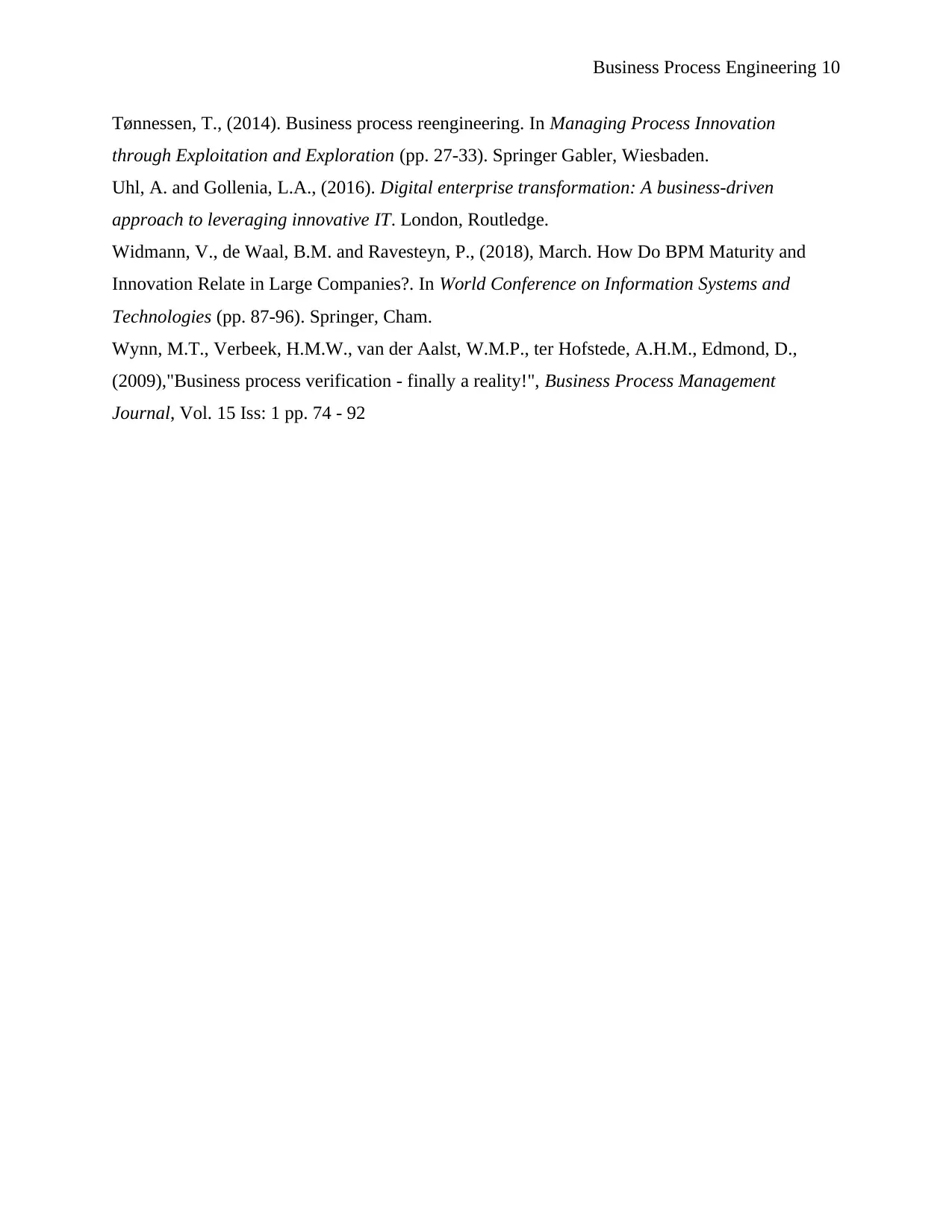
Business Process Engineering 10
Tønnessen, T., (2014). Business process reengineering. In Managing Process Innovation
through Exploitation and Exploration (pp. 27-33). Springer Gabler, Wiesbaden.
Uhl, A. and Gollenia, L.A., (2016). Digital enterprise transformation: A business-driven
approach to leveraging innovative IT. London, Routledge.
Widmann, V., de Waal, B.M. and Ravesteyn, P., (2018), March. How Do BPM Maturity and
Innovation Relate in Large Companies?. In World Conference on Information Systems and
Technologies (pp. 87-96). Springer, Cham.
Wynn, M.T., Verbeek, H.M.W., van der Aalst, W.M.P., ter Hofstede, A.H.M., Edmond, D.,
(2009),"Business process verification - finally a reality!", Business Process Management
Journal, Vol. 15 Iss: 1 pp. 74 - 92
Tønnessen, T., (2014). Business process reengineering. In Managing Process Innovation
through Exploitation and Exploration (pp. 27-33). Springer Gabler, Wiesbaden.
Uhl, A. and Gollenia, L.A., (2016). Digital enterprise transformation: A business-driven
approach to leveraging innovative IT. London, Routledge.
Widmann, V., de Waal, B.M. and Ravesteyn, P., (2018), March. How Do BPM Maturity and
Innovation Relate in Large Companies?. In World Conference on Information Systems and
Technologies (pp. 87-96). Springer, Cham.
Wynn, M.T., Verbeek, H.M.W., van der Aalst, W.M.P., ter Hofstede, A.H.M., Edmond, D.,
(2009),"Business process verification - finally a reality!", Business Process Management
Journal, Vol. 15 Iss: 1 pp. 74 - 92
1 out of 10
Your All-in-One AI-Powered Toolkit for Academic Success.
+13062052269
info@desklib.com
Available 24*7 on WhatsApp / Email
![[object Object]](/_next/static/media/star-bottom.7253800d.svg)
Unlock your academic potential
Copyright © 2020–2025 A2Z Services. All Rights Reserved. Developed and managed by ZUCOL.